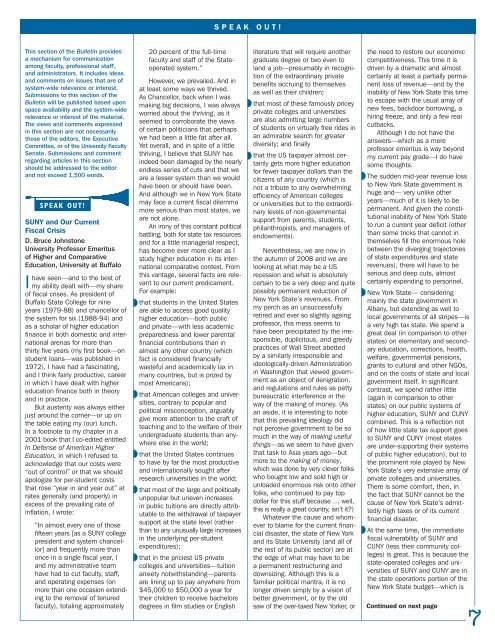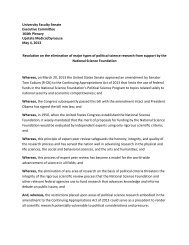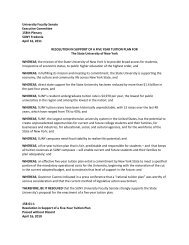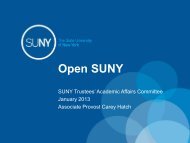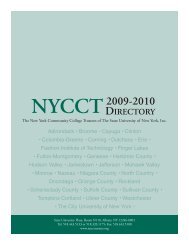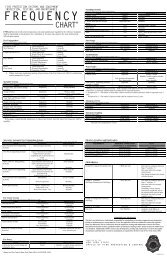Layout 1 copy - The State University of New York
Layout 1 copy - The State University of New York
Layout 1 copy - The State University of New York
You also want an ePaper? Increase the reach of your titles
YUMPU automatically turns print PDFs into web optimized ePapers that Google loves.
S P E A K O U T !<br />
This section <strong>of</strong> the Bulletin provides<br />
a mechanism for communication<br />
among faculty, pr<strong>of</strong>essional staff',<br />
and administrators. It includes ideas<br />
and comments on issues that are <strong>of</strong><br />
system-wide relevance or interest.<br />
Submissions to this section <strong>of</strong> the<br />
Bulletin will be published based upon<br />
space availability and the system-wide<br />
relevance or interest <strong>of</strong> the material.<br />
<strong>The</strong> views and comments expressed<br />
in this section are not necessarily<br />
those <strong>of</strong> the editors, the Executive<br />
Committee, or <strong>of</strong> the <strong>University</strong> Faculty<br />
Senate. Submissions and comment<br />
regarding articles in this section<br />
should be addressed to the editor<br />
and not exceed 1,500 words.<br />
SPEAK OUT!<br />
SUNY and Our Current<br />
Fiscal Crisis<br />
D. Bruce Johnstone<br />
<strong>University</strong> Pr<strong>of</strong>essor Emeritus<br />
<strong>of</strong> Higher and Comparative<br />
Education, <strong>University</strong> at Buffalo<br />
Ihave seen—and to the best <strong>of</strong><br />
my ability dealt with—my share<br />
<strong>of</strong> fiscal crises. As president <strong>of</strong><br />
Buffalo <strong>State</strong> College for nine<br />
years (1979-88) and chancellor <strong>of</strong><br />
the system for six (1988-94) and<br />
as a scholar <strong>of</strong> higher education<br />
finance in both domestic and international<br />
arenas for more than<br />
thirty five years (my first book—on<br />
student loans—was published in<br />
1972), I have had a fascinating,<br />
and I think fairly productive, career<br />
in which I have dealt with higher<br />
education finance both in theory<br />
and in practice.<br />
But austerity was always either<br />
just around the corner—or up on<br />
the table eating my (our) lunch.<br />
In a footnote to my chapter in a<br />
2001 book that I co-edited entitled<br />
In Defense <strong>of</strong> American Higher<br />
Education, in which I refused to<br />
acknowledge that our costs were<br />
“out <strong>of</strong> control” or that we should<br />
apologize for per-student costs<br />
that rose “year in and year out” at<br />
rates generally (and properly) in<br />
excess <strong>of</strong> the prevailing rate <strong>of</strong><br />
inflation, I wrote:<br />
“In almost every one <strong>of</strong> those<br />
fifteen years [as a SUNY college<br />
president and system chancellor]<br />
and frequently more than<br />
once in a single fiscal year, I<br />
and my administrative team<br />
have had to cut faculty, staff,<br />
and operating expenses (on<br />
more than one occasion extending<br />
to the removal <strong>of</strong> tenured<br />
faculty), totaling approximately<br />
20 percent <strong>of</strong> the full-time<br />
faculty and staff <strong>of</strong> the <strong>State</strong>operated<br />
system.”<br />
However, we prevailed. And in<br />
at least some ways we thrived.<br />
As Chancellor, back when I was<br />
making big decisions, I was always<br />
worried about the thriving, as it<br />
seemed to corroborate the views<br />
<strong>of</strong> certain politicians that perhaps<br />
we had been a little fat after all.<br />
Yet overall, and in spite <strong>of</strong> a little<br />
thriving, I believe that SUNY has<br />
indeed been damaged by the nearly<br />
endless series <strong>of</strong> cuts and that we<br />
are a lesser system than we would<br />
have been or should have been.<br />
And although we in <strong>New</strong> <strong>York</strong> <strong>State</strong><br />
may face a current fiscal dilemma<br />
more serious than most states, we<br />
are not alone.<br />
An irony <strong>of</strong> this constant political<br />
battling, both for state tax resources<br />
and for a little managerial respect,<br />
has become ever more clear as I<br />
study higher education in its international<br />
comparative context. From<br />
this vantage, several facts are relevant<br />
to our current predicament.<br />
For example:<br />
that students in the United <strong>State</strong>s<br />
are able to access good quality<br />
higher education—both public<br />
and private—with less academic<br />
preparedness and lower parental<br />
financial contributions than in<br />
almost any other country (which<br />
fact is considered financially<br />
wasteful and academically lax in<br />
many countries, but is prized by<br />
most Americans);<br />
that American colleges and universities,<br />
contrary to popular and<br />
political misconception, arguably<br />
give more attention to the craft <strong>of</strong><br />
teaching and to the welfare <strong>of</strong> their<br />
undergraduate students than anywhere<br />
else in the world;<br />
that the United <strong>State</strong>s continues<br />
to have by far the most productive<br />
and internationally sought after<br />
research universities in the world;<br />
that most <strong>of</strong> the large and politically<br />
unpopular but uneven increases<br />
in public tuitions are directly attributable<br />
to the withdrawal <strong>of</strong> taxpayer<br />
support at the state level (rather<br />
than to any unusually large increases<br />
in the underlying per-student<br />
expenditures);<br />
that in the priciest US private<br />
colleges and universities—tuition<br />
anxiety notwithstanding—parents<br />
are lining up to pay anywhere from<br />
$45,000 to $50,000 a year for<br />
their children to receive bachelors<br />
degrees in film studies or English<br />
◗<br />
◗<br />
◗<br />
◗<br />
◗<br />
◗<br />
◗<br />
literature that will require another<br />
graduate degree or two even to<br />
land a job—presumably in recognition<br />
<strong>of</strong> the extraordinary private<br />
benefits accruing to themselves<br />
as well as their children;<br />
that most <strong>of</strong> these famously pricey<br />
private colleges and universities<br />
are also admitting large numbers<br />
<strong>of</strong> students on virtually free rides in<br />
an admirable search for greater<br />
diversity; and finally<br />
that the US taxpayer almost certainly<br />
gets more higher education<br />
for fewer taxpayer dollars than the<br />
citizens <strong>of</strong> any country (which is<br />
not a tribute to any overwhelming<br />
efficiency <strong>of</strong> American colleges<br />
or universities but to the extraordinary<br />
levels <strong>of</strong> non-governmental<br />
support from parents, students,<br />
philanthropists, and managers <strong>of</strong><br />
endowments).<br />
Nevertheless, we are now in<br />
the autumn <strong>of</strong> 2008 and we are<br />
looking at what may be a US<br />
recession and what is absolutely<br />
certain to be a very deep and quite<br />
possibly permanent reduction <strong>of</strong><br />
<strong>New</strong> <strong>York</strong> <strong>State</strong>’s revenues. From<br />
my perch as an unsuccessfully<br />
retired and ever so slightly ageing<br />
pr<strong>of</strong>essor, this mess seems to<br />
have been precipitated by the irresponsible,<br />
duplicitous, and greedy<br />
practices <strong>of</strong> Wall Street abetted<br />
by a similarly irresponsible and<br />
ideologically-driven Administration<br />
in Washington that viewed government<br />
as an object <strong>of</strong> denigration,<br />
and regulations and rules as petty<br />
bureaucratic interference in the<br />
way <strong>of</strong> the making <strong>of</strong> money. (As<br />
an aside, it is interesting to note<br />
that this prevailing ideology did<br />
not perceive government to be so<br />
much in the way <strong>of</strong> making useful<br />
things—as we seem to have given<br />
that task to Asia years ago—but<br />
more to the making <strong>of</strong> money,<br />
which was done by very clever folks<br />
who bought low and sold high or<br />
unloaded enormous risk onto other<br />
folks, who continued to pay top<br />
dollar for this stuff because … well,<br />
this is really a great country, isn’t it?)<br />
Whatever the cause and whomever<br />
to blame for the current financial<br />
disaster, the state <strong>of</strong> <strong>New</strong> <strong>York</strong><br />
and its <strong>State</strong> <strong>University</strong> (and all <strong>of</strong><br />
the rest <strong>of</strong> its public sector) are at<br />
the edge <strong>of</strong> what may have to be<br />
a permanent restructuring and<br />
downsizing. Although this is a<br />
familiar political mantra, it is no<br />
longer driven simply by a vision <strong>of</strong><br />
better government, or by the old<br />
saw <strong>of</strong> the over-taxed <strong>New</strong> <strong>York</strong>er, or<br />
◗<br />
◗<br />
◗<br />
the need to restore our economic<br />
competitiveness. This time it is<br />
driven by a dramatic and almost<br />
certainly at least a partially permanent<br />
loss <strong>of</strong> revenue—and by the<br />
inability <strong>of</strong> <strong>New</strong> <strong>York</strong> <strong>State</strong> this time<br />
to escape with the usual array <strong>of</strong><br />
new fees, backdoor borrowing, a<br />
hiring freeze, and only a few real<br />
cutbacks.<br />
Although I do not have the<br />
answers—which as a mere<br />
pr<strong>of</strong>essor emeritus is way beyond<br />
my current pay grade—I do have<br />
some thoughts.<br />
<strong>The</strong> sudden mid-year revenue loss<br />
to <strong>New</strong> <strong>York</strong> <strong>State</strong> government is<br />
huge and— very unlike other<br />
years—much <strong>of</strong> it is likely to be<br />
permanent. And given the constitutional<br />
inability <strong>of</strong> <strong>New</strong> <strong>York</strong> <strong>State</strong><br />
to run a current year deficit (other<br />
than some tricks that cannot in<br />
themselves fill the enormous hole<br />
between the diverging trajectories<br />
<strong>of</strong> state expenditures and state<br />
revenues), there will have to be<br />
serious and deep cuts, almost<br />
certainly expending to personnel.<br />
<strong>New</strong> <strong>York</strong> <strong>State</strong>— considering<br />
mainly the state government in<br />
Albany, but extending as well to<br />
local governments <strong>of</strong> all stripes—is<br />
a very high tax state. We spend a<br />
great deal (in comparison to other<br />
states) on elementary and secondary<br />
education, corrections, health,<br />
welfare, governmental pensions,<br />
grants to cultural and other NGOs,<br />
and on the costs <strong>of</strong> state and local<br />
government itself. In significant<br />
contrast, we spend rather little<br />
(again in comparison to other<br />
states) on our public systems <strong>of</strong><br />
higher education, SUNY and CUNY<br />
combined. This is a reflection not<br />
<strong>of</strong> how little state tax support goes<br />
to SUNY and CUNY (most states<br />
are under-supporting their systems<br />
<strong>of</strong> public higher education), but to<br />
the prominent role played by <strong>New</strong><br />
<strong>York</strong> <strong>State</strong>’s very extensive array <strong>of</strong><br />
private colleges and universities.<br />
<strong>The</strong>re is some comfort, then, in<br />
the fact that SUNY cannot be the<br />
cause <strong>of</strong> <strong>New</strong> <strong>York</strong> <strong>State</strong>’s admittedly<br />
high taxes or <strong>of</strong> its current<br />
financial disaster.<br />
At the same time, the immediate<br />
fiscal vulnerability <strong>of</strong> SUNY and<br />
CUNY (less their community colleges)<br />
is great. This is because the<br />
state-operated colleges and universities<br />
<strong>of</strong> SUNY and CUNY are in<br />
the state operations portion <strong>of</strong> the<br />
<strong>New</strong> <strong>York</strong> <strong>State</strong> budget—which is<br />
Continued on next page<br />
7


